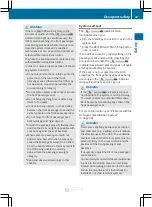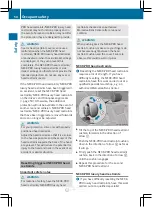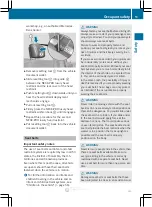
keep both feet on the floor in front of the
seat.
R
When using a seat belt to secure infant
restraints, toddler restraints, or children in
booster seats, always follow the child seat
manufacturer's instructions.
Do not pass seat belts over sharp edges. They
could tear.
Do not allow the seat belt to get caught in the
door or in the seat adjustment mechanism.
This could damage the seat belt.
Never attempt to make modifications to seat
belts. This could impair the effectiveness of
the seat belts.
According to accident statistics, children are
safer when properly restrained on the rear
seats than on the front-passenger seat. Thus,
we strongly recommend that children be
placed in the rear seat whenever possible.
Regardless of seating position, children 12
years old and under must be seated and
properly secured in an appropriately sized
child restraint system or booster seat
recommended for the size and weight of the
child. For additional information, see the
"Children in the vehicle" section.
A child's risk of serious or fatal injuries is
significantly increased if the child restraints
are not properly secured in the vehicle and/
or the child is not properly secured in the child
restraint.
X
Adjust the seat and move the backrest to
an almost vertical position (
X
Pull the seat belt smoothly through belt
sash guide
:
.
X
Without twisting it, guide the shoulder
section of the seat belt across the middle
of your shoulder and the lap section across
your hips.
X
Engage belt tongue
;
in buckle
=
.
Seat-belt adjustment: if necessary, the
driver's and front-passenger seat belts
automatically adjust to the upper body
(
X
If necessary, adjust the seat belt to the
appropriate height (
X
If necessary, pull upwards on the shoulder
section of the seat belt to tighten the belt
across your body.
All seat belts except the driver's seat belt are
equipped with a special seat belt retractor to
securely fasten child restraint systems in the
vehicle. For further information on special
seat belt retractors, see (
Occupant safety
53
Safety
Z
Summary of Contents for R 350 2012
Page 1: ...R Class Operator s Manual I n f o r m a t i o nP r o v i d e db y ...
Page 4: ...I n f o r m a t i o nP r o v i d e db y ...
Page 28: ...26 I n f o r m a t i o nP r o v i d e db y ...
Page 38: ...36 I n f o r m a t i o nP r o v i d e db y ...
Page 72: ...70 I n f o r m a t i o nP r o v i d e db y ...
Page 96: ...94 I n f o r m a t i o nP r o v i d e db y ...
Page 130: ...128 I n f o r m a t i o nP r o v i d e db y ...
Page 198: ...196 I n f o r m a t i o nP r o v i d e db y ...
Page 282: ...280 I n f o r m a t i o nP r o v i d e db y ...
Page 322: ...320 I n f o r m a t i o nP r o v i d e db y ...
Page 352: ...350 I n f o r m a t i o nP r o v i d e db y ...
Page 364: ...362 I n f o r m a t i o nP r o v i d e db y ...
Page 365: ...363 I n f o r m a t i o nP r o v i d e db y ...
Page 366: ...364 I n f o r m a t i o nP r o v i d e db y ...
















































